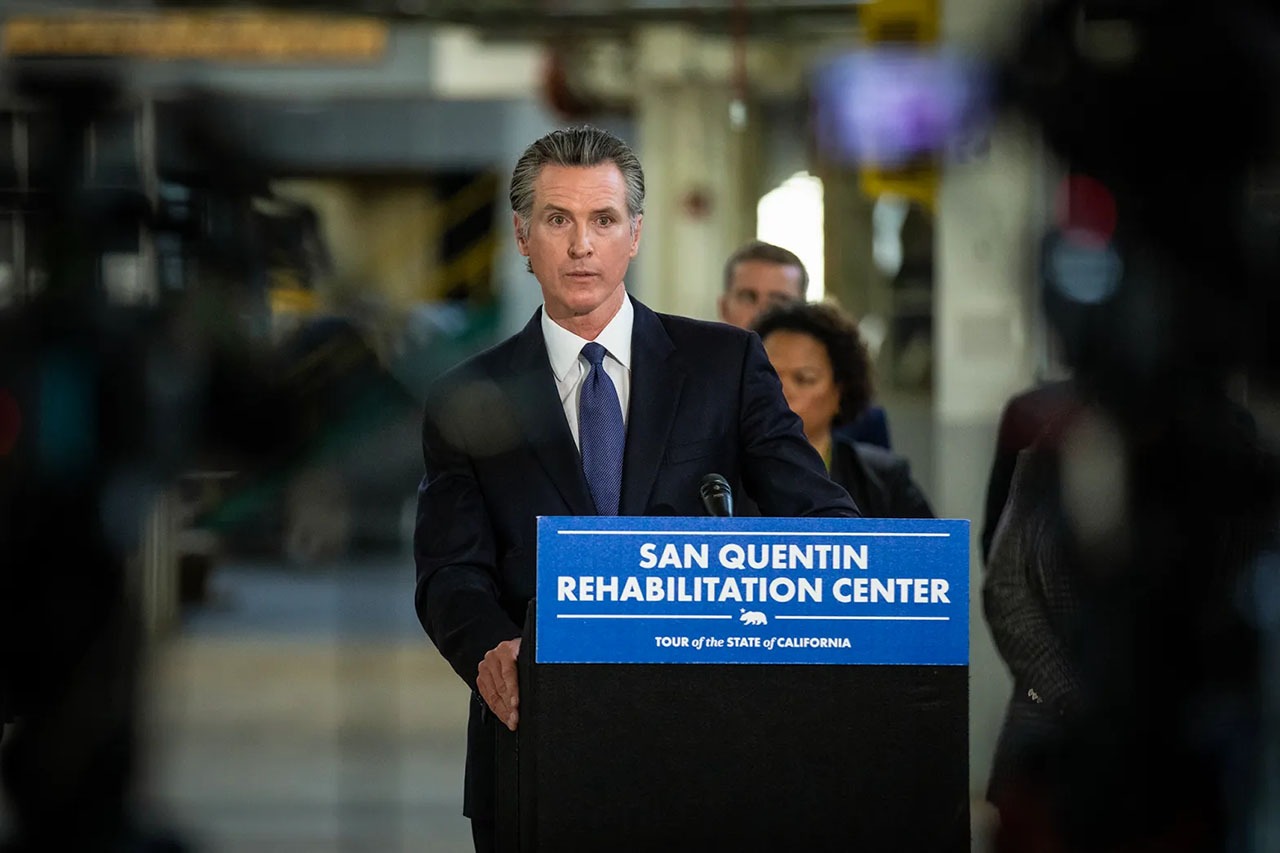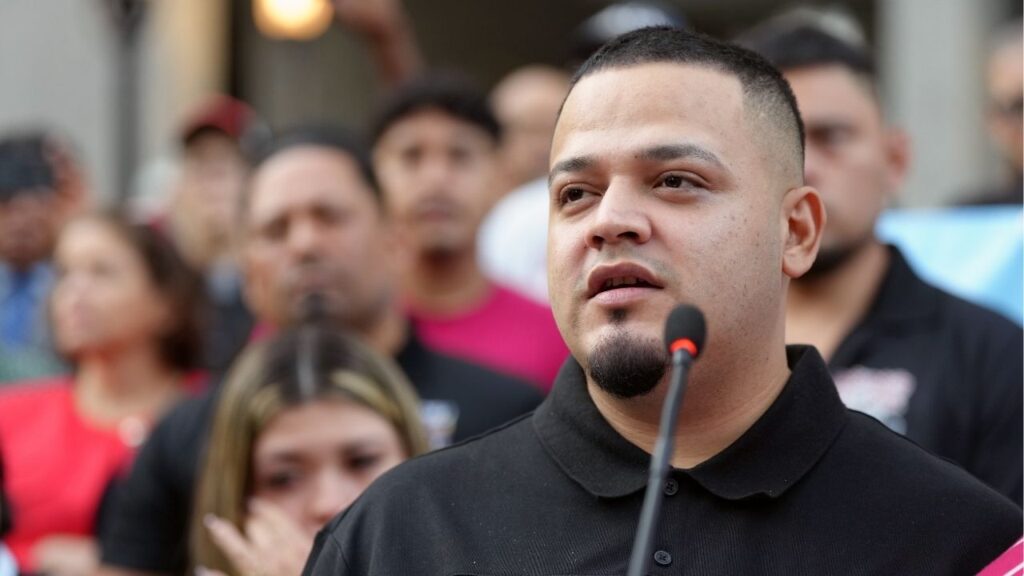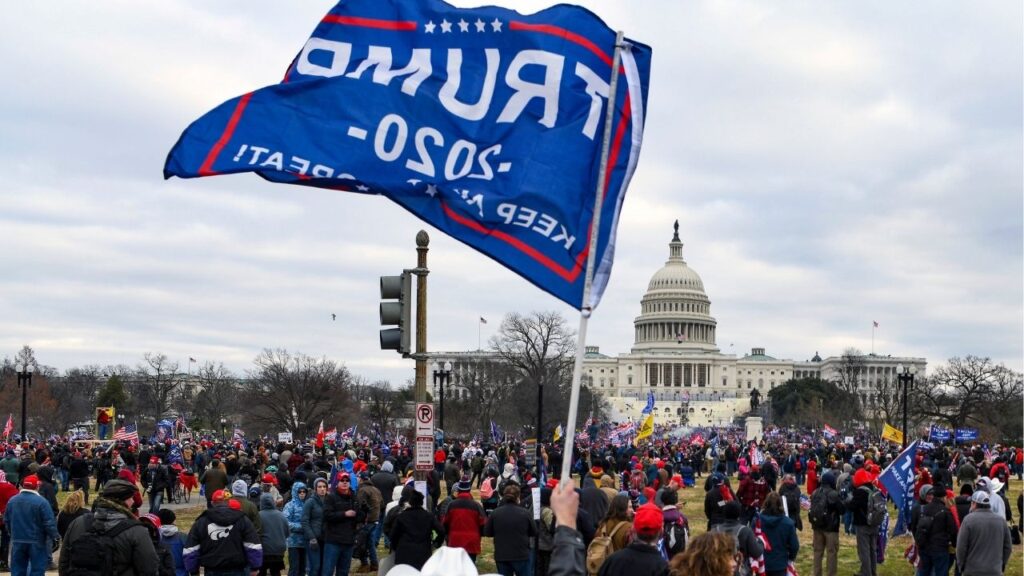The California Correctional Peace Officers Association faces a complicated political environment as inmate populations decline and calls to close prisons increase. (CalMatters/Pablo Unzueta)

- The prison guard union has given $2.9 million to Gov. Newsom since his election, 31% of its total political spending since 2001.
- Newsom has closed some prisons but stopped short of further closures despite facing a budget deficit.
- Some see the spending surge as the union fighting to stay relevant as California shifts away from mass incarceration.
Share
|
Getting your Trinity Audio player ready...
|
The California Correctional Peace Officers Association, better known as CCPOA, represents about 26,000 state prison guards. It increased its political spending after Gov. Gavin Newsom took office.

Nigel Duara
CalMatters

Jeremia Kimelman
CalMatters
A year after he took the top job in 2019, the president of one of California’s largest and most powerful unions said in a newsletter that he wanted to be “the 800 pound gorilla” in Sacramento politics.
Since then, the California Correctional Peace Officers Association, the union known as CCPOA representing 26,000 state prison guards, has spent and spent, in a way it never did before. Its biggest recipient: Gov. Gavin Newsom, who has taken $2.9 million from the union since he was elected governor.
That’s 31% of all political spending by the union since 2001.
The union under President Glen Stailey gave $1.75 million to Newsom’s anti-recall campaign in 2021 – the largest single contribution to that effort – and another $1 million to support Proposition 1, Newsom’s treatment and housing plan for people experiencing serious mental illness, which passed by the narrowest of margins this year.
Related Story: Gavin Newsom Backs Down on Crime Measure
That’s a noted contrast to the union’s relationship with the three governors who preceded Newsom, especially former Gov. Arnold Schwarzenegger, who fought the union’s proposed raises and was the target of an aborted recall campaign launched by the union.
Prior to the Newsom administration, the prison union’s biggest political expense came in 2005, when it joined other labor organizations in fighting a package of ballot measures sponsored by Schwarzenegger that would have curbed state spending and weakened public employee unions. The unions won, dealing Schwarzenegger a major defeat.
Campaign finance records show the union largely stayed out of political fights during former Gov. Jerry Brown’s administration. It avoided the ballot measures that lowered criminal sentences for nonviolent crimes and gave inmates more opportunities for parole — propositions that voters passed and that contributed to declining headcounts in state prisons.
Then Newsom took office, and the union’s pocketbook opened wide.
There are two ways to look at that spending, according to interviews with legislators, labor leaders, former prison officials and budget watchdogs.
In one, it’s a naked display of power: one of the richest unions in a labor-friendly state reminding its top politicians that it can spend with them — or against them. That’s primarily the view from outside the Capitol.
In the other view, from inside the Capitol, it’s a reflection of the union’s anxiety in the face of waning influence as California’s future almost certainly includes fewer prisons and fewer union-represented prison guards to staff them. The numbers don’t lie: California is housing 70,000 fewer inmates in state prisons than it did in 2011.
At the outset of his first term, Newsom floated the idea of closing a single state prison. He’s since closed three and canceled a contract on another private prison, collectively saving hundreds of millions of dollars. But facing a budget deficit and 4,000 fewer inmates projected to be in prison by the end of his term in 2026, Newsom demurred this year from shutting down another institution.
In a year of budget scarcity, when each inmate costs about $132,000 to house annually and the Legislative Analyst’s Office has said the state has space to close five more prisons, Newsom has been stubborn about keeping prisons open. He has said he wants to keep some additional capacity in the system, and that he wants to build up rehabilitative programs that can help inmates reintegrate into society.
Related Story: Gavin Newsom for President? These Are His Assets and Liabilities
Izzy Gardon, a spokesperson for Newsom, in a written statement said the governor has tried to balance potential budget savings with public safety needs inside prisons.
“Saving taxpayers billions of dollars without impacting public safety, Gov. Newsom has closed more prisons than any of his predecessors,” she wrote. “The governor’s decisions have been based exclusively on meeting the evolving needs of our criminal justice system, in a manner that maximizes public safety and the judicious use of taxpayer dollars.
Nathan Ballard, an adviser to the union and a longtime Newsom ally, said in written responses to questions from CalMatters that the union and the governor had “respectful and substantive” discussions about potential prison closures this budget cycle.
“Union leaders clearly aired their views and listened very carefully to the administration’s priorities,” Ballard said. “The governor made it known that he valued the union’s input. Ultimately, Gov. Newsom’s process is his own, and it would be irresponsible to speculate about how he arrives at any particular decision.”
The millions of dollars the union shoveled into Newsom’s most significant projects were a reflection of the union’s priorities, he said.
“When the union and the governor are in alignment policy-wise, as they were during Proposition 1, the CCPOA does not hesitate to fight hard for the governor’s initiatives,” he said.
“Even while grappling with policy areas where they are less aligned, there is a strong commitment to finding areas of agreement and progress.”
CCPOA’s Big Contracts in Newsom Years
Spending lots of money to support the most powerful executive in the state is perhaps not surprising. So what happens to the politicians who cross the prison guard union?
When the union wanted to get rid of John Moorlach, a Republican state senator who was questioning pension benefits for California public employees, it spent more than $1 million against him in his Orange County race. Then the flyers started popping up, sponsored by the union, tying the Never Trumper senator to the policies and personal predilections of Donald Trump.
“It was cartoonish,” said Lance Christensen, Moorloch’s campaign manager in that 2020 race. “You would think that the public safety unions whose job it is to serve and defend and protect Californians would want a guy like John Moorlach, who was law and order and supportive generally of public safety programs.”

The prison guard union has spent $3.8 million across 32 state legislative races in this century – $1.2 million of that was spent to defeat Moorlach. He lost to Democrat Dave Min, 51%-49%.
“They decided that it was time to go hammer and tong after him, and take him out,” Christensen said.
The union, which represents about 10% of all state workers, has undoubtedly gotten good deals for its members, arguably none more so than last year, when it negotiated a $1 billion raise over three years. Correctional officers also got a new state-funded retirement perk out of the deal, in addition to their California Public Employees’ Retirement System pensions. And when the state mandated COVID-19 vaccinations for state employees, prison guards were permitted to skip them.
That spending has consistently come under fire from the Legislative Analyst’s Office, which found in 2019 and 2021 that the Newsom administration offered “no evidence to justify (a) pay increase” in an unusually harsh analysis of proposed prison guard raises.
The analysis found that California prison guards have neither a recruitment nor a retention problem, and that their salaries were already in line with the salaries in the counties where they work – if not more than 5% higher than comparable job classifications.
Last year, the Legislative Analyst’s Office excoriated Newsom’s administration for repeatedly refusing to make public a 2018 compensation study on prison guard salaries and benefits. The administration regularly publishes compensation studies regarding its 18 other employee bargaining units.
Instead, the administration provided a 2022 compensation study, which the Legislative Analyst’s Office called “flawed” for its failure to account for overtime pay and its selection of large, metropolitan counties as pay comparison points rather than the rural areas where most prison guards work.
“The study is flawed to the point that it is not helpful in meeting its stated objective and we recommend policymakers not use it to assess whether the state’s compensation package for correctional officers is appropriate to attract and retain qualified workers,” according to the Legislative Analyst’s Office.
Those raises, said Brian Kaneda, deputy director for Californians United for a Responsible Budget, put the state’s budget crisis in sharper relief.
“The CCPOA has a stranglehold on Sacramento politics,” Kaneda said. “Everyone’s struggling right now, but prison guards are getting a $1 billion raise. Explain how this could possibly be the right move for California as we tussle with this historic budget deficit.”
When asked to gauge the union’s influence in Sacramento and the diverging views on its power, Ballard said union leadership concentrates on its members more than its lobby.
“The union’s leaders are focused on matters of character, not reputation,” he said. “The CCPOA’s leaders are street-smart correctional officers who have worked in very tough conditions for decades, and as a group they are not terribly concerned with perceived status.”
Is CCPOA a Factor in Newsom’s Prison Closures?
Newsom began identifying prisons to close in 2020. More followed in 2022. Then, Newsom stopped naming additional prisons to close even though they have thousands of empty beds.
What changed? For one, people’s perception of crime spiked in the pandemic — though the kind of crimes that would merit prison time mostly went down.
For a governor who perhaps has ambitions beyond Sacramento, that’s important, said one Democratic legislator who did not want their name used for fear of retaliation by both the governor’s office and the prison guard union.
“I don’t think the CCPOA is the reason we’ve stalled on prison closures,” said the legislator. “I think it’s the governor himself or someone in the governor’s office protecting (the California Department of Corrections and Rehabilitation).
“My presumption is the governor is moderating his views on public safety because of where he wants to go nationally. And so he’s super careful about any perception of being soft on crime.”

In its heyday during the prison building boom of the 1990s and 2000s, the prison guard union would never have had to account for such calculations, said former Corrections Secretary Matt Cate. Back then, both parties had incentives to make nice with the union.
“At the time, the Democrats were more moderate than they are now and they were doing everything to support labor generally,” said Cate, who was appointed corrections secretary in 2008 by Schwarzenegger and stayed for two years under Brown, leaving the office in 2011. “Meanwhile, Republicans were staunchly in favor of law enforcement and long sentences because they didn’t believe in rehabilitation and re-entry.
“So CCPOA had an open field. It was just a much easier job than what the CCPOA faces today. It’s not as easy today to be an 800-pound gorilla as it would have been 20 years ago.”
Cate doubts the union is the sole reason, or even the main reason, that Newsom stopped designating prisons for closure. Closing a prison is like closing “a small city,” Cate said, with 3,000 inmates and 800-1,000 employees represented by a dozen or more different unions. The prison system’s health care is managed by a federal monitor, and another federal monitor oversees the state’s prison mental health care.
Taking on a Democrat, and Losing
One legislator who crossed the prison union and whose career survived was Assemblymember Reggie Jones-Sawyer, a Los Angeles Democrat, who said the sharp-elbowed tactics employed by the union under Stailey, its president, were reflective of the union’s approach in the 1990s, a time when the union’s power was at its height.
“If they sneezed,” he said, “people got a cold.”
In 2020, Jones-Sawyer fell into their crosshairs, literally.
Related Story: Gavin Newsom Will Take Your Biden Questions (and Try Your Doughnuts)
The union ran an online ad against Jones-Sawyer that showed Stailey pointing at a wall of photos of legislators. Over Jones-Sawyer’s photo was a piece of white paper with crosshairs and a red dot. Jones-Sawyer took that as a threat, and the union pledged to pull the ad down and re-edit it.
“It became clear that if they wanted to get back the power, they needed to take somebody out to put the fear into everybody,” said Jones-Sawyer, who won re-election that year. “They thought I was an easy target to take out. They learned that was not the case.”

Jones-Sawyer notes that the union didn’t spend much under former Gov. Brown – not until the threat of prison closures became a reality after Newsom’s election in 2018.
“Once they started talking about closing prisons, that’s when the fear from the CCPOA came up,” Jones-Sawyer said. “That’s when they started writing double max-out checks.”
Jones-Sawyer said he’s frustrated by what he sees as abuses within the prison system, especially guards with multiple infractions keeping their jobs. The Office of the Inspector General earlier this year found that the corrections department had reclassified a backlog of staff misconduct complaints as “routine grievances,” and allowed the statute of limitations to expire in 127 complaints between 2022 and 2023.
Now, Jones-Sawyer said, he’s considering calling for an audit of the prison system’s facilities and spending.
“When (the corrections department) comes back and says this is the best way to do it, we try to see their logic and a lot of times we don’t,” he said.
Are those hard-charging tactics isolating the prison union? One bill introduced this year may be an indication. The bill would limit the number of empty beds available in the prison system to account for the declining inmate population.
Among the bill’s registered supporters are immigration advocates, the California Public Defenders Association and anti-incarceration lobbies.
There was just one group registered in opposition: the CCPOA.
About the Authors
Nigel Duara joined CalMatters in 2020 as a Los Angeles-based reporter covering poverty and inequality issues for our California Divide collaboration. Previously, he served as a national and climate correspondent on the HBO show VICE News Tonight. Before that, he was the border correspondent at the Los Angeles Times based in Phoenix, deployed to stories across the country. He is a longtime contributor to Portland Monthly magazine and graduated from the University of Missouri School of Journalism.
Jeremia is a data journalist who uses code and data to make policy and politicians easier to understand. He was previously a graphics editor at the COVID Tracking Project and a data journalist at NBC News covering elections and national politics. He grew up in California and is excited to be back home after an extended time as a New Yorker. When he isn’t on the computer you can find him out in the garden or on a bicycle.
About CalMatters
CalMatters is a nonprofit, nonpartisan newsroom committed to explaining California policy and politics.
RELATED TOPICS:
Categories

Fresno County Firefighters Contain Reedley House Fire


















